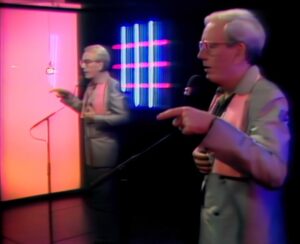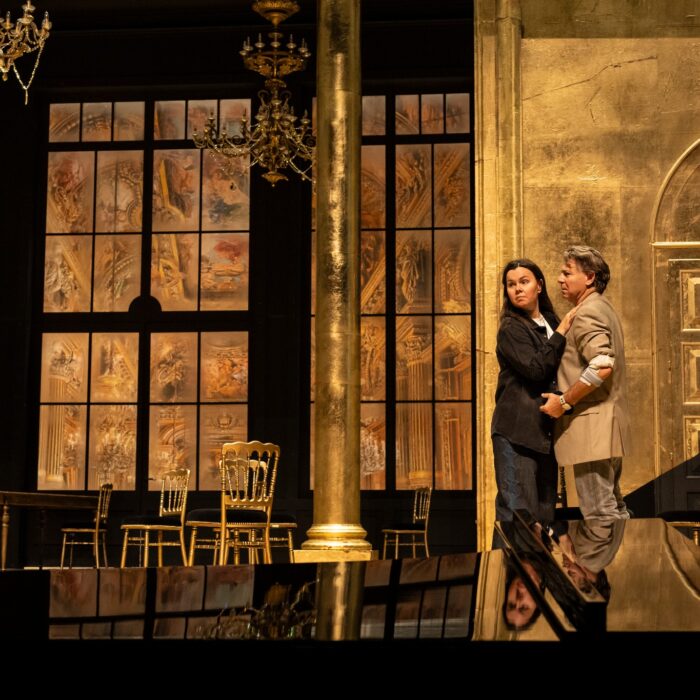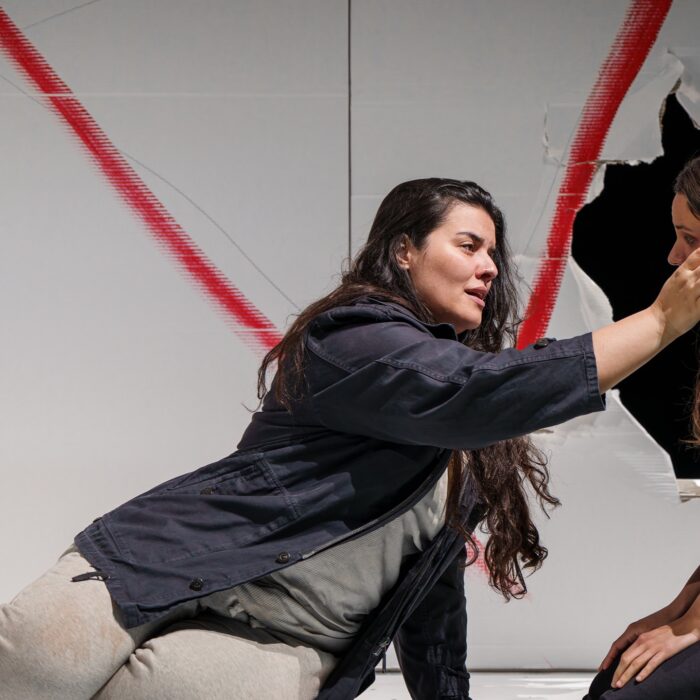
Opera Meets Film: Robert Ashley’s TV Opera ‘Perfect Lives’
By Joe CadaginIt’s easier to appreciate Robert Ashley’s 1983 “Perfect Lives” by simply accepting it on faith as an “opera” rather than try to cram it into the narrow definition established for the genre. There’s quite a bit of text, some singing, a story with characters, and perhaps too much of a visual spectacle. Purists with preconceived notions about how exactly these elements should fit together needn’t give “Perfect Lives” a passing glance.
But for those of us with open minds and adventurous spirits, Ashley’s opera—recently remastered on Blu-ray by Lovely Music—offers a bizarre yet transcendental experience.
“Perfect Lives” Beyond the Veil of Triviality
Ashley dubbed it “an opera for television.” However, “Perfect Lives” is nothing like “Amahl and the Night Visitors” or “Owen Wingrave”—works that premiered as studio broadcasts but transfer perfectly well to the opera house. The televisual is embedded into the very concept of “Perfect Lives,” which is divided into seven 25-minute episodes. Ashley’s text makes frequent allusions to the camera angles and editing effects onscreen. Its non-linearity also demands the kinds of cuts, montages, and superimposition that can only be executed on video. It would be absurd to imagine a “staged” version.
What is “Perfect Lives” about? This is, fundamentally, the wrong question to ask. Granted, there’s some semblance of a plot: a group of conspirators in a small Midwestern town pull off a bank heist. Only, the culprits don’t plan to keep the cash. After transporting the stolen money across state lines, they promptly return it to the vault. Their strange caper stands as “a metaphor for something philosophical,” as Ashley wryly puts it in his synopsis.
Philosophical is the key word. The events of the opera, including a series of vignettes tangentially related to the robbery, largely serve as a platform for Ashley’s musings on life and metaphysics. These are recited by the composer himself in a monologue that fills some 140 pages in its printed edition. As the characters go about their humdrum activities—driving a rusted car to Indiana, buying canned succotash, sitting on a bench in a courthouse park—they make arcane observations, like Zen monks pondering existence. Unsurprisingly, Ashley was reading the Tibetan Book of the Dead when he wrote the libretto.
The juxtaposition of corn-belt banality with lofty philosophizing is intentionally comical. The opera never takes itself too seriously, and there are jokes aplenty. In one scene, an elderly couple ponders what would happen if the grocery store suddenly became sentient. In another, Buddy the pianist delivers a discourse on man’s spiritual development in between snippets of folksy conversation overheard at a dive bar. Beneath the irony, there’s something deeper at play—a reminder that even the mundane is endowed with meaning and mysticism, if we only know how to look beyond the veil of triviality.
Just as Plato spoke through Socrates and his interlocutors, Ashely performs the dialogue for all his dramatis personae in addition to the narration. Occasionally, a two-voice “chorus” chimes in with a cheeky aside or to emphasize an important phrase. But mostly we hear and see a leisure-suited Ashley in a studio: silk scarf around his neck, glitter spray in his hair, too much foundation on his face. On the wall behind him is an assortment of neon lights, whose colors and positions change from episode to episode. It has all the vaguely uncanny feel of a late-night public-access program. Indeed, the opera first aired on a British public-service channel at 10pm.
Ashely’s storytelling could never be mistaken for arioso or recitative—it’s closer to the heightened speech of epic poetry, with Ashley posing as a postmodern Homeric bard. Yet, the composer referred to the episodes of “Perfect Lives” as “songs” and to his declamation as “singing.” Certainly, his vocal cadence possesses an innate musicality. In one list-form passage, each repetition of the word “and” is drawn out into a playground chant, with sing-songy rises and dips. Pages from his performance text, reproduced on the inside flaps of the Blu-ray case, reveal a personalized notation of asterisks and underlines.
Robert Ashley’s Hypnotic Voice
Ashley’s drawl, though one might hesitate to call it that, since he was raised in Michigan, is positively hypnotic. It resembles the soft-spoken self-assurance of Matthew McConaughey’s laid-back intonation. Granted, this often proves a drawback. There are large stretches that are virtually unintelligible, rendering it impossible to follow his more abstruse commentary. Subtitles were inexplicably not included on this re-release; a copy of the published libretto is a must-have to avoid feeling totally at sea.
Ashely had composed dozens of works at the time of “Private Lives” and went on to write both the text and music for a vast Wagnerian cycle, to which this opera belongs. Yet what one might call the “score”—referred to in the credits by the TV industry term “music beds”—was largely the creation of producer Peter Gordon and pianist “Blue” Gene Tyranny. Each track, preceding at an invariable 72 beats per minute, is grounded in a drum-machine beat layered with dreamy synth sounds. Over this, Tyranny improvises solos in a range of styles: lounge music, supermarket Muzak, boogie-woogie, honky-tonk, classic jazz, and minimalism.
It isn’t mere background music—in the performance libretto, Tyranny’s chord changes are closely coordinated with Ashley’s words. In fact, many of the episodes even emulate conventional operatic forms. Episode two has a kind of ternary structure, in the pattern of a Baroque da capo number. Occasionally, there’s some actual singing, like the idiotic pop-song parody “Coo Coo,” hilariously droned in a bored monotone by backup vocalists Jill Kroesen and David Van Tieghem. The tune reappears throughout Episode three like a ritornello or the recurring refrain of a rondò aria.
Aside from the master shot of Ashley, as well as some cross-cutting to Tyranny’s bejeweled hands at the keyboard, director John Sanborn intersperses filmed depictions of the opera’s action. They’re more like reenactments than realistic portrayals. The entire cast of characters is represented by a pair of eccentric stand-in figures played by Kroesen and Van Tieghem. Decked in sunglasses, old-fashioned bathing caps, and garish tunics, they come off like a couple of mischievous alien visitors. The videography editing by Dean Winkler—undoubtedly state-of-the-art for the early ’80s—is charmingly dated now, with its swipes, text overlays, and rotating cubes. While the HD upgrade significantly cleans up the picture, there’s still some inevitable VHS fuzziness and halo effects. But many viewers will welcome the nostalgic “vaporwave” aesthetic of the whole affair, with its fabulous pink-and-green palette.
Making Sense of “Perfect Lives”
By the seventh and final episode, it becomes clear that “Perfect Lives” exists as something simultaneously ridiculous and cosmic. Isolde, one of the bank-heist plotters, steps into her mother’s backyard at twilight, constellations rising behind her and picknickers assembled on the lawn like a miniature solar system. In her mind, she practices meditation exercises and ponders the cryptic significance of numbers that crop up in her daily life. An electronic dance riff somewhat undermines the poetic beauty of this passage, as do Ashley’s cheeky, self-aware remarks like “God, this is sentimental.” Tyranny’s arpeggiated progression, straight from Chopin or Rachmaninov, is just on the verge of kitsch. And yet, for all its sweetness and silliness, this scene instills a profound sense of reassurance—an impression that everything is connected and that all will be well. It’s one of the mysteries of this enigmatic opera that keeps fanatics returning with religious devotion. “What about the Bible? What about the Koran?,” asked John Cage. “It doesn’t matter. We have ‘Perfect Lives.’”



